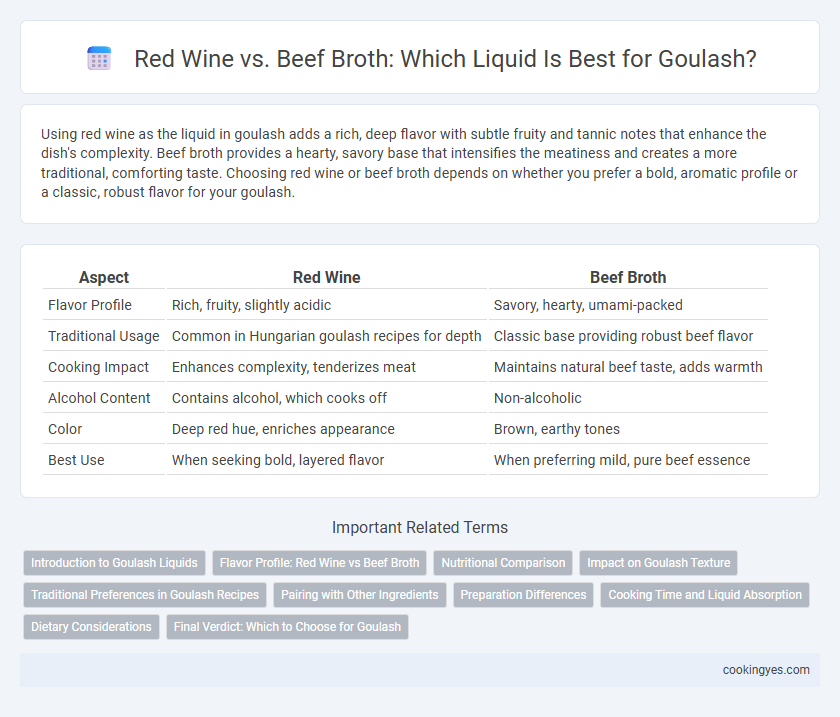Using red wine as the liquid in goulash adds a rich, deep flavor with subtle fruity and tannic notes that enhance the dish's complexity. Beef broth provides a hearty, savory base that intensifies the meatiness and creates a more traditional, comforting taste. Choosing red wine or beef broth depends on whether you prefer a bold, aromatic profile or a classic, robust flavor for your goulash.
Table of Comparison
| Aspect | Red Wine | Beef Broth |
|---|---|---|
| Flavor Profile | Rich, fruity, slightly acidic | Savory, hearty, umami-packed |
| Traditional Usage | Common in Hungarian goulash recipes for depth | Classic base providing robust beef flavor |
| Cooking Impact | Enhances complexity, tenderizes meat | Maintains natural beef taste, adds warmth |
| Alcohol Content | Contains alcohol, which cooks off | Non-alcoholic |
| Color | Deep red hue, enriches appearance | Brown, earthy tones |
| Best Use | When seeking bold, layered flavor | When preferring mild, pure beef essence |
Introduction to Goulash Liquids
Goulash traditionally relies on liquids like red wine or beef broth to develop its rich, hearty flavor and tender texture. Red wine adds a deep, fruity complexity and subtle acidity that enhances the paprika and spices, while beef broth offers a robust, savory base that intensifies the meat's natural taste. Choosing between red wine and beef broth impacts the final aroma, depth, and mouthfeel of goulash, making liquid selection a crucial step in authentic preparation.
Flavor Profile: Red Wine vs Beef Broth
Red wine imparts a rich, fruity acidity with deep tannins that enhance the goulash's complexity and provide a robust, slightly sweet undertone. Beef broth offers a savory, umami base with a hearty, meaty flavor that deepens the stew's richness and balances spices without overwhelming the palate. Using red wine creates a more vibrant, layered flavor, while beef broth delivers comfort and fullness, making each liquid choice distinctive in shaping the goulash's taste profile.
Nutritional Comparison
Red wine and beef broth offer distinct nutritional profiles when used as the liquid base for goulash. Red wine contributes antioxidants such as resveratrol and has a moderate calorie content, while beef broth is rich in protein, collagen, minerals like calcium and magnesium, and is typically lower in calories. Choosing beef broth enhances the dish's protein and mineral intake, whereas red wine adds beneficial polyphenols and deeper flavor complexity.
Impact on Goulash Texture
Red wine enhances goulash texture by tenderizing the meat through its acidity and adding a rich, slightly syrupy mouthfeel. Beef broth contributes a fuller body and a more robust, savory consistency that thickens the stew naturally. Combining both liquids balances the tender meat fibers with a hearty, velvety texture, creating a complex and satisfying goulash.
Traditional Preferences in Goulash Recipes
Traditional goulash recipes often favor beef broth over red wine as the primary cooking liquid, emphasizing its rich, savory depth that enhances the hearty flavors of the meat and paprika. Red wine is sometimes added for complexity and a subtle acidity but is less common in authentic Hungarian preparations where beef broth provides a more authentic, robust base. The preference for beef broth reflects the dish's rustic origins and regional availability of ingredients in Hungary.
Pairing with Other Ingredients
Red wine enhances goulash with rich acidity and fruity undertones, complementing the sweetness of tomatoes and the earthiness of paprika, while adding depth to the beef's flavor. Beef broth provides a savory, umami base that intensifies the meatiness and harmonizes with root vegetables like carrots and potatoes. Selecting red wine or beef broth as the cooking liquid influences the overall taste profile and the balance of herbs such as bay leaves and thyme within the dish.
Preparation Differences
Using red wine in goulash imparts a rich, fruity acidity that enhances the dish's depth, requiring careful simmering to mellow the alcohol and concentrate flavors. Beef broth offers a savory, umami base that delivers a more robust and hearty taste, accelerating the tenderization of the beef during cooking. The choice between red wine and beef broth significantly influences the cooking time and flavor profile, with wine generally needing longer reduction for balanced complexity, while broth provides immediate richness.
Cooking Time and Liquid Absorption
Using red wine in goulash enhances flavor complexity but requires longer cooking time for alcohol to evaporate and flavors to meld properly. Beef broth provides a rich, savory base that is quickly absorbed by the meat and vegetables, reducing overall cooking time. Adjusting liquid choices affects both tenderness and taste intensity, with broth promoting faster liquid absorption and wine offering deeper, more nuanced flavors during extended simmering.
Dietary Considerations
Choosing between red wine and beef broth as the liquid base for goulash affects dietary preferences and restrictions significantly. Red wine adds depth and antioxidants but contains alcohol, making it unsuitable for those avoiding alcohol due to health, religious, or personal reasons. Beef broth provides a rich, savory flavor without alcohol, suitable for low-sodium or low-fat dietary needs when using a broth with controlled seasoning.
Final Verdict: Which to Choose for Goulash
Choosing between red wine and beef broth for goulash liquid depends on the desired flavor depth and richness. Red wine imparts a robust, slightly acidic complexity that enhances the meat's natural taste, while beef broth offers a savory, hearty base that intensifies the dish's comfort and warmth. For a traditional, well-balanced goulash, combining both ingredients often yields the best results, blending acidity and umami in perfect harmony.
Red wine vs beef broth for goulash liquid Infographic

 cookingyes.com
cookingyes.com